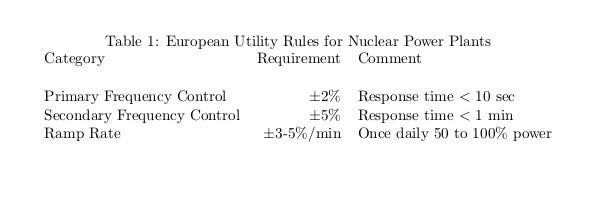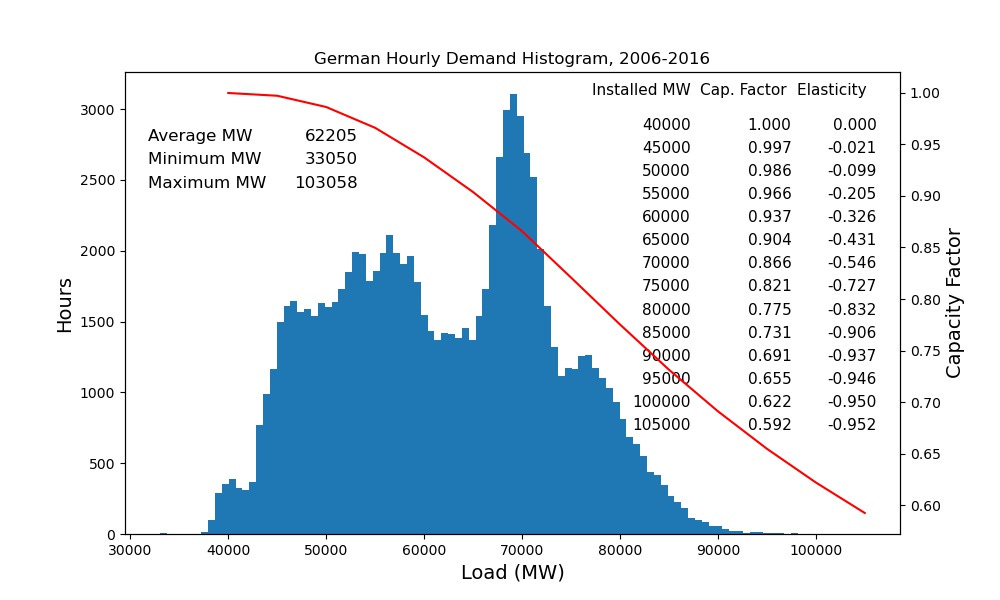Nuclear power cannot load follow
There is a widespread belief that nuclear reactors cannot load follow. Nuclear power plants not only can load follow, in Europe it is a utility requirement. The European Utility Rules(EUR) for nuclear power plants are summarized in Table 1.
Most modern designs exceed these requirements by a comfortable margin. For example, the Westinghouse AP1000 claims to be able to maintain a ramp rate of 5% per minute over a 15 to 100% load range. Such ramp rates easily handle all normal diurnal variations in demand. Consider the CAISO duck, Figure 1. Even with wind/solar making the net demand pattern far worse than the underlying demand, the required ramp rate in the critical 5:30 PM to 7:30 PM period is about 0.5%/minute.
Figure 1. California ISO March Diurnal Load Profile
Nuclear has been load following in France for at least 20 years. Figure 2 shows the power output of a French plant for ten days in December, 2008. The plant is adjusting between 90% to 100% on a hourly basis, but with nearly daily dips down into the 30's.
Figure 2. French plant Output, December 2008.
The load following problem for nuclear is not technical, but economic. Nuclear is a high capital cost, low marginal cost source of electricity. In base load mode, a well run nuclear plant can have a capacity factor of better than 0.90. Assuming efficient regulation and a 0.90 capacity factor, nuclear power could produce electricity at 3 or 4 cents per kWh of which about 0.5 cents is variable cost, almost all fuel. At this capacity factor, the life cycle CO2 intensity would be about 5 gCO2/kWh. But if we attempt to cover all the variation in demand with nuclear, that capacity factor will drop, and the carbon intensity will rise.
Let's take Germany as an example. Figure 3 is a histogram of the hourly German demand from 2006 to 2016 inclusive. The peak demand is 1.66 times the average demand. If we attempted to build an all nuclear grid to meet this demand profile, we would need to install enough nuclear to meet the peak demand. Our capacity factor would be 0.9 / 1.66 = 0.54, and the cost of electricity would nearly double, and the CO2 intensity would rise to 7 gCO2/kWh.
Figure 3. Germany Hourly Demand, 2006-2016 inclusive. Red line is nuke capacity factor as a function of nuclear installed capacity.
But the peak demand occurred in only 1 hour in 11 years. It makes no sense to spend the resources required to cover the upper tail via nuclear. Once you get up to 90,000 MW's installed, the elasticity of the capacity factor is nearly -1.0. For each additional 1% in installed capacity, the capacity factor drops by almost 1%. That additional capacity is sitting idle almost all the time.
Suppose we decide to install 70,000 MW's of nuclear, 20,000 MW's of Combined Cycle Gas Turbines, and cover the rest with Open Cycle Gas Turbines. Table 2 summarizes the results
Table 2. Capacity factors for 70/20/13 GW nuke/CCGT/OCGT grid, Germany from 2006 to 2016.
The Open Cycle Gas Turbine is running only 46 hours in 11 years, Such a plant requires far less steel, concrete, and just about everything else per GW than a nuclear power plant. If we were silly enough to waste a lot of money (read resources) to cover those 46 hours with nuclear, we would increase the grid CO2 emissions, for the Life Cycle CO2 associated with those 13 GW of nuclear would be larger than the Life Cycle CO2 of the gas turbine plus its fuel emissions. For a far better and more complete analysis of the German situation, see Low CO2 Electricity: the Options for Germany
The point is an all nuclear grid will almost never be optimal. There is no such thing aas a zero CO2 grid; but there is hope for the purists. If and only if we have truly cheap nuclear, then we can have low CO2 synfuel, in which case the fossil fuel peaking becomes synfuel peaking. We could have truly cheap nuclear, but only if we have a regulatory revolution.







Depends on where you are. The Swiss Nant de Drance project took advantage of two existing reservoirs, separated by 425 m vertical. Cost over 2 billion dollars for 20 GWh, about $104/kWh. And if you need the 900 MW for more than 22 hours, you're screwed. That's if you have ideal topography and the dam is already there. You won't find any mountains in northern Germany. In fact, you will find very few hills. For almost everywhere, a bit of gas turbine is the way to go, economically and environmentally.
The GKG model assumes that the hourly demand must be met. So yes that last bit is expensive, and you can imagine load shedding schemes. But the impact on the overall cost of electricity is small. Please see Low CO2 electricity: the options for Germany at gordianknotbook.com. And the OCGT perform two other important functions. They handle unplanned outages and unexpected load spikes.
The GKG model assumes perfect foresight. In the real world, we do not have that luxury. Any decent grid needs reserve capacity which by definition means it is almost never used.